
The art of the charcuterie board goes far beyond the fancy ones you’ve seen on your screen. These Instagram-worthy adult Lunchables have ancient origins and meticulous methods that make them an even more appealing option for your dinner party. From the authentic to the adventurous, here’s how to take a pedestrian cheese plate and turn it into sensational charcuterie.
How to make a charcuterie board
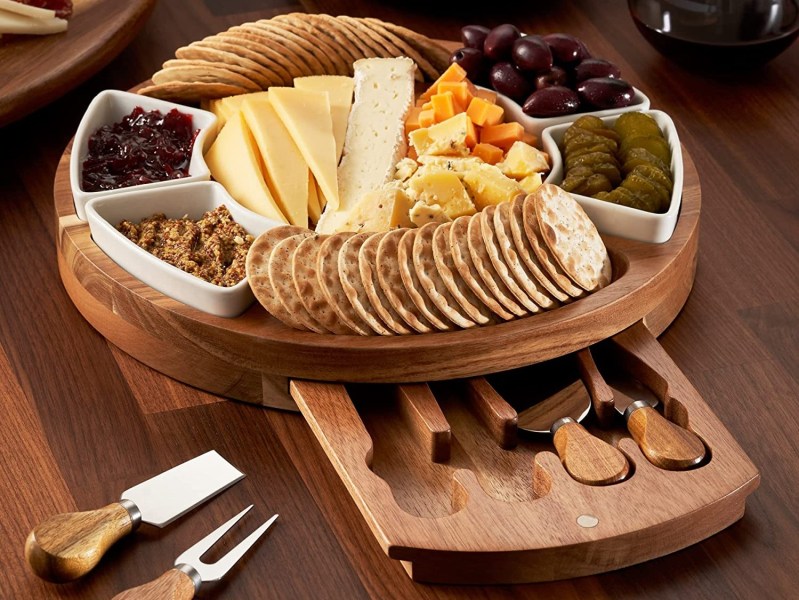
Charcuterie boards should offer an array of flavors and textures that offer contrasting and complementing tastes in each bite. How the board elements are displayed is quintessential to its allure, but there are no specific rules to follow. Be as whimsical as you wish, playing with colors and layers, adding as much or as little as you think your guests will enjoy.
There are many fancy charcuterie serving boards on the market; however, they can get quite expensive. A porcelain tray, slate board, or, if you still want that rustic look, a wooden cutting board are all perfect options.
French-style charcuterie board
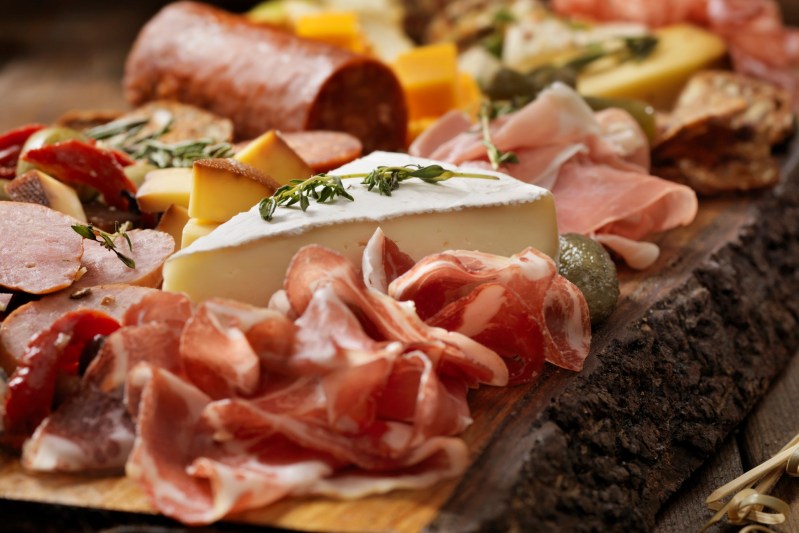
The architects tend to keep their trays quite traditional. On the typical French board, you’ll find a combination of offal or organ meat spreads, and accouterments like pickles and cheese, and of course a lot of crusty bread. While not extravagant, the French charcuterie is an elegant and essential addition to any apéro hour.
French dry-cured meats
Jambon Sec Supérieur
This premier pork is cured for over six months and is highly regarded since it comes from an antique pig breed that is raised and processed in the traditional French manner.
Varieties:
- Bigorre
- Basque Country
- Gascony
Jambon Sec
The Champagne of salt-cured pork in France, Jambon Sec is often referred to as the French version of prosciutto.
Varieties:
- Bayona
- Ardennes
- Savoie
- Auvergne
- Laucaune
- Najac
Jambon Cru
A more common salt-cured ham, varieties from the Northern region are often smoked.
Varieties:
- Vendée
- Alsacia
Salami
Le Saucisson Sec
A classic French dry-cured sausage, this thick and mild meat can vary in flavor and ingredients based on the region.
Varieties:
- Saucisson d’Arles
- Saucisson d’Alsace
- Saucisson de Lyon
- Aucisson aux noisettes
Offal spreads
Pâtés
Traditionally made of liver mixed with spices and wine, pâtés are a paste of ground organs, meats, and seasonings. They usually contain a portion of chicken, goose, or duck liver and either wine or brandy.
Varieties:
- Pâté Chaud
- Pâté de Foie Gras
- Pâté Grand Mère
- Pâté Maison
- Pâté Hénaff
Terrines
A pâté of anything from meats, seafood, or vegetables with boiled eggs and herbs wrapped in a pastry baked specifically in a terrine pan.
Varieties:
- Saint-Hubert terrine
- Pâté en croûte
- Terrine de canard
Rillettes
A classic French confit of pork that has been slow-cooked and stored in fat.
Varieties:
- Rillettes de Porc
- Rillettes de canard
- Rillettes de saumon
Cheeses
Cow cheese
- Morbier
- Brie de Meaux
- Saint-André
- Reblochon
- Camembert
- Vieux Boulogne
- Brillat-Savarin
- Port Salut
Goat
- Florette
- Tomme de chèvre
- Bûcheron
- Sainte-Maure
- Crottin de Chavignol
- Valençay
Blue
- Bleu d’Auvergne
- Roquefort
Hard cheese
- Mimolette
- Comté
- Etorki
- Gruyère
- Beaufort
Accouterments
- French radishes
- Salted nuts
- Cornichons
- Grapes
- Olives
- Dijon mustard
- Baguette
Wine pairings
White wine
- Riesling
- Sancerre
- Pinot Gris
Red Wine
- Cabernet Franc
- Rosé
- Gamay
Apéritif
- Byrrh Cassis
- Champagne
- Pastis
Italian-style charcuterie board
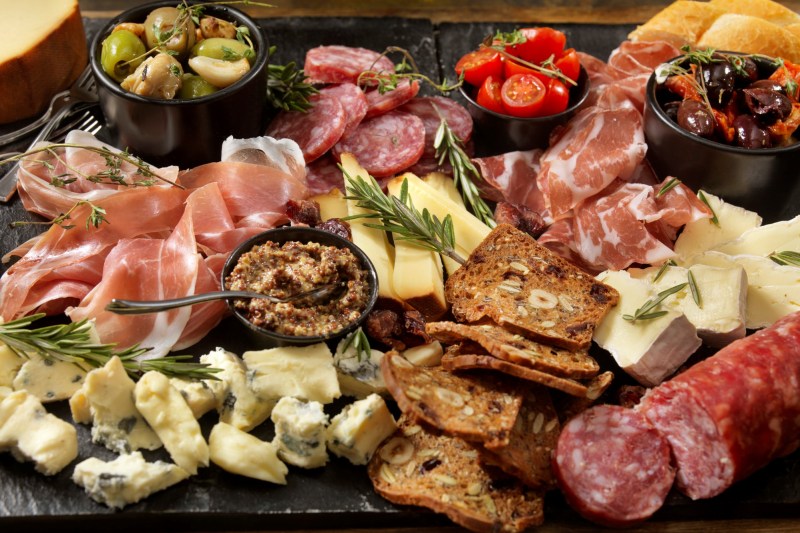
A traditional Italian charcuterie highlights some of the best bites the country has to offer. Usually referred to as Antipasto or antipasti, this spread of meats, cheeses, and marinated vegetables is served as a first course to stimulate the appetite. Acclaimed for some of the best cuisines in the world, Italians have truly mastered the art of cured meat. While these boards are meant to be just the beginning, with so many delicious levels, it’s an aesthetic and sensory feast.
Italian dry-cured meats
Prosciutto
Prosciutto is the most popular Italian ham. It is a naturally cured ham traditionally from Parma. There are many regional variations, each with its distinct flavors.
Varieties:
- Prosciutto di Parma
- Prosciutto Amatricano
- Prosciutto Toscano
Capocolla
A dry-cured ham from the southern region of Italy, Coppa is made from pig shoulder and neck cuts and seasoned with spices like cinnamon, cloves, and nutmeg.
Varieties:
- Coppa di Parma
- Coppa Piacentina
- Capocollo di Calabria
Lonza Stagionata
A very lean, air-dried cured pork loin seasoned with juniper seeds, black pepper, or fennel and typically served with extra virgin olive oil.
Salame
A dry-cured sausage typically made with pork and seasoned with black pepper and garlic. Each region has its own version with an array of meats and seasonings.
Varieties:
- Genoa
- Calabrese
- Milano
- Piccante
- Cacciatore
- Casalingo
Sopressata
Similar to salame, this dry-cured sausage is traditionally made from the leftover cuts of pig and is more coarsely ground than salame, with big chunks of pork and fat visible.
Varieties:
- Sopressata di Calabria
- Sopressata di Puglia
- Sopressata di Basilicata
- Sopressata di Apulia
Braesola
A salt-cured aged beef known for its deep red hue and tougher texture.
Varieties:
- Bresaola della Valtellina
- Beretta Creminelli
- Bresaola della Aosta
Cheeses
- Burrata
- Taleggio
- Formaggi
- Bel Paese
- Fontina
Hard cheese
- Grana Padano
- Parmigiano Reggiano
- Pecorino
- Provolone
Contorno
- Preserved Artichoke
- Preserved Eggplant
- Marinated Olives
- Dried Tomatoes
- Marcona Almonds
- Pinzini
- Grissini
- Crostini
- Pane a l’antico rustico
Wine pairings
White wine
- Cortese
- Vermintino
- Pigato
Red wine
- Lambrusco
- Chianti
- Nebbiolo
Aperitiv
- Proscecco
- Negroni
- Aperol spritz
Adventurous
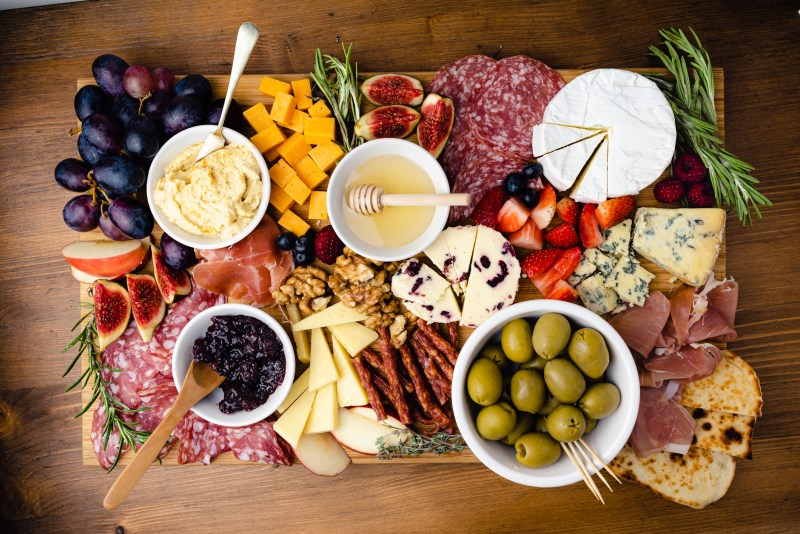
For those ready to take a step away from the traditional, adding an array of modern options allows you to experiment with flavors and textures to create a more diverse charcuterie platter. From seasonal fruit and vegetable spreads to holiday-themed platters, dessert-based boards or different international savory tastes, the creative and cultural combinations are endless.
Meats
Summer sausage, sweet bologna, chorizo, smoked salmon, sardines, pepperoni, dried meat, and turkey.
Cheeses
Vegan cheeses, Irish cheddar, Manchego, smoked gouda, blue cheese, Swiss, Colby jack, cream cheese, goat cheese, and feta cheese.
Fruits
Figs, pomegranates, cherries, grapes, mandarins, strawberries, dried cranberries, blackberries, dates, apricots, Apples, mangos, and cantaloupe.
Vegetables
Carrots, broccoli, celery, radishes, cucumbers, avocado, tomatoes, jalapenos, pickled onions, olives, pistachios, and nuts, and seeds.
Breads
Sourdough, focaccia, tortillas, veggie chips, crackers, pretzels, and flatbread crisps.
Spreads
Hummus, guacamole, pesto, tapenade, jam, chocolate, Nutella, honeycomb, mustard, tzatziki, kimchi, and sauerkraut.
Pairings
Red wine
- Pinot noir
- Cabernet sauvignon
- Rioja
White wine
- Chardonnay
- Sauvignon blanc
- Rose
Cocktails
- Gin and tonic
- Old Fashion
- Sparkling flavored water
Themed
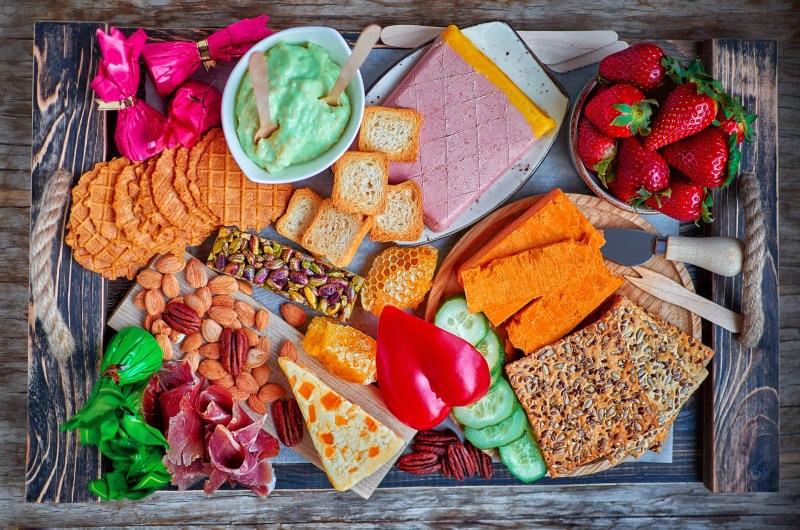
Greek
Feta, olives, tomatoes, stuffed grape leaves, Keftethakia (mini meatballs), tzatziki, Skordalia (potato and garlic dip), Melitzanosalata (roasted eggplant spread), pepperoncini, artichoke hearts, grilled eggplant, pita bread, and bruschetta.
Game Day
Mini sausages, jerky, cocktail shrimp, chopped veggies, stuffed jalapenos, mini bell peppers, pepper jack cheese, blue cheese, horseradish cheddar cheese, queso cheese,
Valentine’s Day
Prosciutto, pepperoni, cherries, strawberries, grapes, figs, gouda, goat cheese, chocolate chips, honey, Nutella, toasted brioche, and dried fruits.
What’s the history of charcuterie boards?
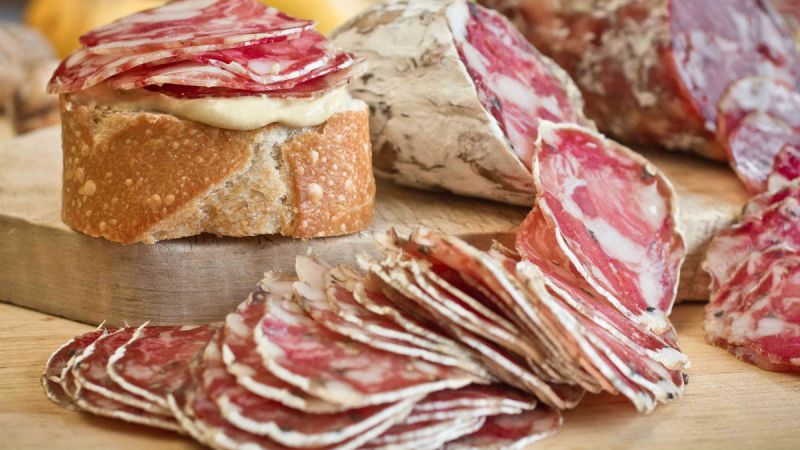
In 15th-century France, the word charcuterie was used to describe the butchers who specialized specifically in prepared pork such as sausage, pâtés, and confit. Over time and across continents, the term has broadened to encompass the preparation and serving of a variety of cured meats, cheeses, and fruits.
Modern charcuterie boards
The charcuterie board as we know it today evolved around the 19th and 20th centuries. Cheeses became a prominent addition, offering a delicious contrast to the cured meats. This shift created a more balanced board with a wider range of flavors and textures. Today’s charcuterie boards often incorporate fruits, nuts, breads, jams, and chutneys, making them a delightful combination of sweet, savory, salty, and sometimes even spicy elements. The rise of social media in recent times has further fueled the popularity of charcuterie boards, with their visually appealing presentation.
Traditionally meant to be enjoyed with wine, the options are endless and can vary by pairing, palette, and preference. While visually appetizing, there is more to these beautiful boards than just aesthetics.



